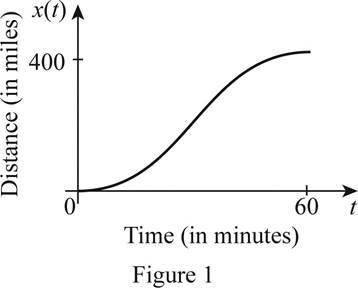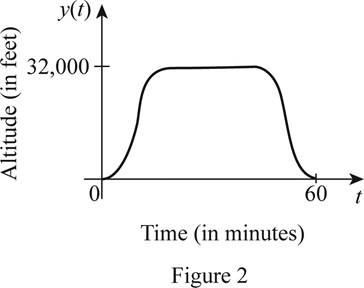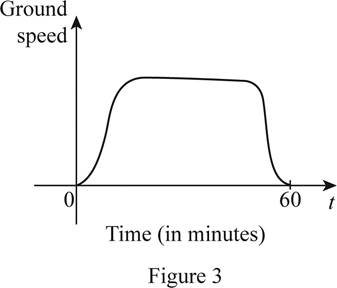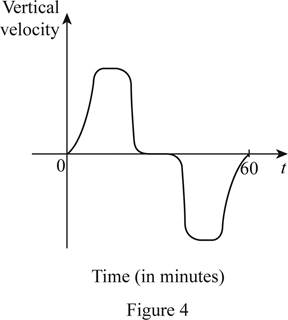
Concept explainers
(a)
To sketch: The rough graph of the horizontal distance traveled
(a)
Explanation of Solution
It is given that

In Figure 1, the increasing curve represents the distance traveled by the airplane in one hour.
(b)
To sketch: The rough graph of the altitude of the plane,
(b)
Explanation of Solution
It is given that

From Figure 2, it is observed that there is a variation in the altitude of the airplane during takeoff and landing time.
(c)
To sketch: A rough graph of the ground speed.
(c)
Explanation of Solution
Ground speed is the relative speed of the airplane to the ground. Generally, the ground speed of the airplane will be slow at the time of take off. Then, the speed will be increased and remains constant after a few minutes of take off. Again, at the time of landing, the ground speed of the airplane will be slow. So, at the initial and landing stage, the speed of the airplane will be slow. The rough graph of ground speed is shown below in Figure 3.

It is observed from Figure 3 that there is a variation in the ground speed of the airplane during the takeoff and landing time.
(d)
To sketch: A possible graph of the vertical velocity.
(d)
Explanation of Solution
The vertical velocity is either positive or negative, as it a

From Figure 4, it is observed that the upper part of the graph is the same as the lower part.
Chapter 1 Solutions
Single Variable Calculus: Concepts and Contexts, Enhanced Edition
 Calculus: Early TranscendentalsCalculusISBN:9781285741550Author:James StewartPublisher:Cengage Learning
Calculus: Early TranscendentalsCalculusISBN:9781285741550Author:James StewartPublisher:Cengage Learning Thomas' Calculus (14th Edition)CalculusISBN:9780134438986Author:Joel R. Hass, Christopher E. Heil, Maurice D. WeirPublisher:PEARSON
Thomas' Calculus (14th Edition)CalculusISBN:9780134438986Author:Joel R. Hass, Christopher E. Heil, Maurice D. WeirPublisher:PEARSON Calculus: Early Transcendentals (3rd Edition)CalculusISBN:9780134763644Author:William L. Briggs, Lyle Cochran, Bernard Gillett, Eric SchulzPublisher:PEARSON
Calculus: Early Transcendentals (3rd Edition)CalculusISBN:9780134763644Author:William L. Briggs, Lyle Cochran, Bernard Gillett, Eric SchulzPublisher:PEARSON Calculus: Early TranscendentalsCalculusISBN:9781319050740Author:Jon Rogawski, Colin Adams, Robert FranzosaPublisher:W. H. Freeman
Calculus: Early TranscendentalsCalculusISBN:9781319050740Author:Jon Rogawski, Colin Adams, Robert FranzosaPublisher:W. H. Freeman
 Calculus: Early Transcendental FunctionsCalculusISBN:9781337552516Author:Ron Larson, Bruce H. EdwardsPublisher:Cengage Learning
Calculus: Early Transcendental FunctionsCalculusISBN:9781337552516Author:Ron Larson, Bruce H. EdwardsPublisher:Cengage Learning





